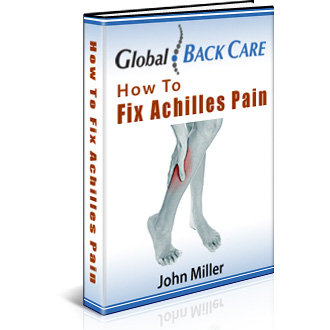If you want to learn how to fix Achilles tendon pain, we can help you!
You’ve got Achilles tendon, calf, shin or heel pain (plantar fasciitis)
- Is it taking months for your Achilles to get better?
- Are your calves so tight you can hardly bear someone to touch them, let alone give them a good massage?
- Is heel pain driving you nuts?
- Is the main tendon running along the sole of your foot, from your big toe to your heel, as tight as a steel cord?
If you want to six Achilles tendon, calf, shin or heel pain – treat the cause, not just the symptoms.
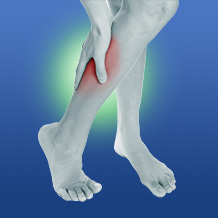
Achilles tendon pain and calf and shin pain are symptoms of a lower body that’s out of alignment. Fixing the problem can be a tough assignment.
If you search the literature and the Internet, you’ll mostly find recommendations like rest, ice, stretching, and taking anti-inflammatory drugs.
They’re useful treatments, and I’ve included them in my mix, but they don’t address the cause of the problem, which is out-of-alignment feet, ankles, legs, and hips coupled with a less-than-perfect foot strike.
In the Fix Achilles, Calf, and Shin Pain ebook, I’ve made every effort to help you identify which parts of your body are out of alignment and provide you with strategies for getting them back into alignment.
If you’ve got calf, Achilles and shin pain, here’s what your feet could look like.
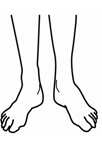 Feet splayed out.
Feet splayed out.
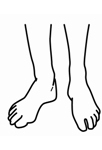
One foot is more splayed than the other.
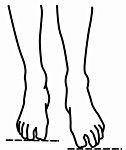 One foot in front of the other.
One foot in front of the other.
And guess what supination and pronation are doing to your calves and Achilles’ tendons?
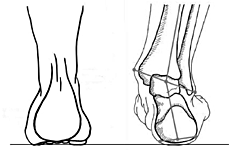 Left foot neutral, right foot pronated.
Left foot neutral, right foot pronated.
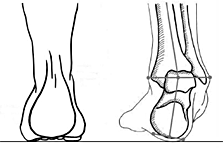 Left foot neutral, right foot supinated.
Left foot neutral, right foot supinated.
If thigh and buttock muscles are tighter on one side than the other, your pelvis will probably be tilted back, rotated or one hip lower than the other. The effect on your calves, Achilles and shins could be pretty dramatic. Every time you walk, jog or run, you put more pressure on one leg than the other.
Every step is doing you harm.
Principles of Musculoskeletal Dysfunction
There are two fundamental principles of musculoskeletal dysfunction:
- It’s muscles that cause bones to move out of alignment. So, when you look at the foot diagrams above, there are muscles somewhere that have fallen down on the job and need to be re-activated.
- The spot where it hurts is probably not where the cause of the problem is located. This means that if you’ve got calf, Achilles and shin pain, you probably need to spend time squaring off your feet, legs and pelvis – rather than just leaving the rehab process to rubbing, heating, icing, vibrating and doping.
You will be predisposed to lower leg pain if your body is out of alignment. You may last for years without a problem, but just a small bit of overuse could bring it on. You think it’s come from out of the blue. You try to pinpoint an incident. Chances are you’ll blame the incident. The last thing you’re likely to do is to blame the long-term effect of the tight and weak muscles attached to your feet, legs and pelvis – and the misalignment that comes with it.
This means that whether you’re a runner, a sportsperson of any kind, or just a regular person doing regular activities, you have to have a program that keeps your feet’ muscles strong and flexible. Such a program extends past trying to push trees over before you go for a run.
Very few people know that maintaining strong and flexible muscles throughout the body is essential for keeping bones in the correct alignment.
So, what sets this book apart?
If there is anything that sets my book apart from others, it is the advice (and exercises) I provide to help you square up your pelvis, legs, and feet.
I will suggest you spend some time each evening doing the same exercises that I recommend to my clients who have back, hip and knee pain.
I recommend you find out whether you’re lop-sided by standing on a pair of scales.

This will provide you with clues about why you are persistently tearing muscles on one side of your body and suggest which exercises will get your skeleton back into better alignment.
There are a heap of other recommendations. Here’s a selection, but you’ll need the book to determine how to do them best.
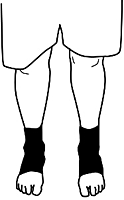 If you have Achilles pain, you’ll get relief with 24-hour icing, using ice packs stuffed down the back of neoprene anklets.
If you have Achilles pain, you’ll get relief with 24-hour icing, using ice packs stuffed down the back of neoprene anklets.
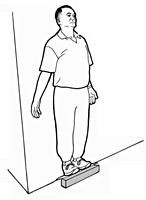 No 1 Achilles and calf stretch
No 1 Achilles and calf stretch
If you have Achilles tendonitis, calf or shin pain, there’s a good chance your foot strike is not quite right. I suggest ways to find out exactly what’s happening as your feet strike the ground.
The book contains recommendations that you may not have heard of. They could make the difference between quickly fixing yourself up or still having Achilles, calf, and shin pain for another 12 months. Imagine what that’s going to do to your training program.
But I’ll let you in on a secret. There is synergy involved in a range of treatments and therapies. There is no one fix.
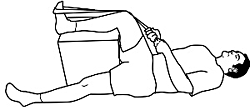
You’ll likely benefit from the combined effect of the small gains you get from a wide range of therapeutic modalities.
Here’s another secret, from yours truly, who’s had Achilles tendonitis, calf and shin pain: constant icing and constant dorsi-flexing.
A particular word about plantar fasciitis, calf and Achilles tendon pain
As for heel pain (plantar fasciitis), there’s nothing better than grinding your calves or the ball of your foot on a massage machine for hours. My experience is that using this machine for long periods – while you work at your desk or while watching TV is the best way to loosen off the main tendon that goes from your big toe through to your heel and relieve heel pain. Use it for loosening off your off your calf muscles.
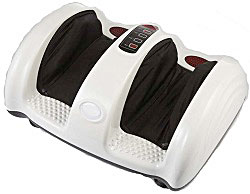
One of these machines costs less than a trip to the physiotherapist. You can use it for hours on end. It’s the cheapest and quickest fix.
Immediately start removing Achilles tendon calf, shin and heel pain.
In the ebook Fix Achilles Tendon Pain, Calf, and Shin Pain, I outline the likely causes of your pain and provide you with exercises and strategies to fix the problem.
I stress the benefits of the persistent use of a range of modalities to fix your dysfunction. But it’s not just about relieving pain; it’s about treating the underlying cause of the problem of which the pain is but a symptom.
How do you know when the problem has been fixed?
When you’re pain-free.
How long will it take?
Strengthening, loosening, and re-aligning are gradual processes that happen bit by bit, nanometre by nanometre, and could take months. But in ten years, you’ll thank the gods that you’ve been pain-free for nine and three-quarter years.
I have a section on working with your podiatrist to analyse your foot strike. If you can’t get your feet right, you will likely suffer from persistent Achilles, calf, and shin pain. You may need wedges or orthotics.
The results of your podiatrist’s work will better equip your shoe salesperson to provide you with the right set of shoes. Calf and Achilles pain may well be a sign that you need a new pair of running shoes. It’s probably best to have several pairs on the go simultaneously. It may be a sign that you better get your aerobic exercise from an activity that doesn’t stress your legs and feet.
I suggest you experiment with your running shoes. I read a review about the difference ‘rocker shoes’ can make to calf and Achilles pain. I also had a friend recommend I get a pair. So I did, and they made a big difference to calf pain and lingering Achilles tendonitis.
I recommend you get a pair. Try them out. What have you got to lose?

A word about taking it easy
My advice: be gentle. If you’re a runner, stop running and start walking. Get on the stepper or cross trainer, cycle, or swim to keep up your aerobic fitness level.
Once you’re confident that the pain has eased sufficiently for you to start jogging (not running) again, only run on grass, begin with 5 minutes the first day, cross-train the second day, and run 6 minutes the third … until you’re back running pain-free.
And take the advice of someone who knows and doesn’t repeat the mistake many runners made: training too soon and too hard. All that will happen is that you’ll end up back where you started.
Remember, calf, Achilles, and shin pain is a multi-factorial problem.
To prevent the pain from coming back, your future training program will need to include strength and flexibility exercises, running, and a daily dose of ‘The Stick’.
The Fix Achilles Tendon Pain Calf and Shin Pain ebook include a complete set of strength and flexibility exercises, advice about shoes, and a range of therapeutic modalities that will help you on the road to recovery.
Purchase the Achilles Tendon, Calf and Shin Pain ebook, and I’ll show you where to look for possible causes of your calf, Achilles, heel and shin discomfort, and I’ll show you what you can do to relieve it.
I’ll give you a suite of exercises that will get your feet, legs and pelvis back into better alignment and well supported by strong muscles. You can’t ask for more than that, except you’re going to save yourself a fortune in medical costs.
I’ll teach you to become your therapist.
Best of all, an investment in the Fix Calf, Achilles and Shin Pain ebook is $7us; that’s less than the price of a couple of cups of coffee.
BUY the Fix Achilles Tendon Pain, Calf or Shin Pain NOW For ONLY $7us
The Fix Achilles tendon pain Calf and Shin is yours to download as soon as you’ve sent us your order
You can start doing the exercises in a couple of minutes.
Delivered to your computer in minutes.
Want more information? Use the contact form to send me an email.
Regards and best wishes for a pain-free life.
John Miller


